Journal of Modern Physics, 2018, 9, 287-301
http://www.scirp.org/journal/jmp
ISSN Online: 2153-120X
ISSN Print: 2153-1196
Infrared Polarizabilities of 3d-Transition and
Rare-Earth Metals
Kofi Nuroh
Department of Mathematical Sciences, Kent State University, Salem, OH, USA
How to cite this paper: Nuroh, K. (2018)
Infrared Polarizabilities of 3d-Transition and
Rare-Earth Metals. Journal of Modern Phys-
ics, 9, 287-301.
https://doi.org/10.4236/jmp.2018.92020
Received: December 31, 2017
Accepted: January 21, 2018
Published: January 24, 2018
Copyright © 2018 by author and
Scientific Research Publishing Inc.
This work is licensed under the Creative
Commons Attribution International
License (CC BY 4.0).
http://creativecommons.org/licenses/by/4.0/
Open Access
4.0
sr =
Abstract
A transition or rare-earth metal is modeled as the atom immersed in a jellium
at intermediate electron gas densities specified by
. The ground states
of the spherical jellium atom are constructed based on the Hohenberg-Kohn-
Sham density-functional formalism with the inclusion of electron-electron
self-interaction corrections of Perdew and Zunger. Static and dynamic polari-
zabilities of the jellium atom are deduced using time-dependent linear response
theory in a local density approximation as formulated by Stott and Zaremba.
The calculation is extended to include the intervening elements In, Xe, Cs, and
Ba. The calculation demonstrates how the Lindhard dielectric function can be
modified to apply to non-simple metals treated in the jellium model.
Keywords
Infrared, Polarizability, Jellium, Transition Metals, Rare-Earth Metals,
Electron Self-Interaction Correction
(
)α ω and its corresponding static value,
1. Introduction
( )0α
The dynamical polarizability,
for metals, have been investigated theoretically by mainly using aggregate of par-
( )0α has been shown to have an ano-
ticles to mimic the metal. In particular,
malous enhancement over its classical expected value of
, where R is
some characteristic radius of the metallic particle. In 1965, Gor’kov and Eliash-
berg (GE) [1] introduced the idea of exploring the electronic excitations of small
metallic particles based on phenomenological temperature-dependent statistical
mechanics. With this concept they provided an explanation to the anomalous
( )0α . This insight generated interest in the physics of small
enhancement in
metallic particles and similar investigations ensued thereafter that exploited other
theoretical methods. In general, these theoretical approaches may be classified
( )
0
α =
3
R
DOI: 10.4236/jmp.2018.92020 Jan. 24, 2018
287
Journal of Modern Physics
�
K. Nuroh
into three grouping: those based on GEs original concept [2]-[15], those that rely
on random phase approximation (RPA) and its variants [16] [17], and those that
use self-consistent density-functional ideas [18]-[23].
,nl
and
, (with
l
α ε=
We utilize the following model as a means of mimicking the medal. A transi-
tion or a rare-earth metal atom is immersed in a uniform electron gas of density
sr , namely, the jellium model. The ground state of the spherical
prescribed by
jellium atom consisting of the discrete core levels and the continuum valence states
are determined using the density functional prescription of Perdew and Zunger
[24]. Since the prescription includes correction for electron self-interactions, it
would provide a more accurate account of electron-electron interactions. A
Thomas-Fermi pseudopotential has been used as the external potential to de-
termine the initial density of the system. This serves as input to the Hohenberg-
Kohn-Sham density-functional scheme [25] [26] to be described in Section II.
Once the self-consistent complete set of energies {
}ασε and wavefunctions
{
}
( )
σ= ± ) are determined, they are subjected to
ασψ r
a time-dependent linear density approximation (TDLDA) methods [27] [28] [29]
[30], that have been so successfully used to determine the polarizability of sys-
tems possessing spherical symmetry. The spherical jellium model is a crude one;
nonetheless, calculations based on this model would serve as a first approxima-
tion for more realistic calculations that should have to incorporate the transla-
tional symmetry of the solid, especially in the transition metal atoms where the
itinerant character of the valence states are crucial for many metallic properties.
In the jellium model, the response of the interacting electron gas to an exter-
(
)
,ε ωq
nal potential
.
If the external potential is weak, linear response theory may be invoked leading
(
)
,P ωq
to a complex polarization function
. Further, if the lowest term contri-
( ) (
)
)
(
)
P ωq
,P ωq
,
,
ω =
bution to
, namely,
)
(
)
)
(
,ε ωq
ε ω ε ω
+
is proportional to
, where
1
1
(
q
The Lindhard expression for this quantity is given in, e.g., Fetter and Walecka
is retained, then we get
( ) (
)
P ωq
leads to a complex dynamic dielectric function
RPAε
.
)
(
,φ ωq
1
2
q
q
(
,
,
i
2
,
1
1
[31] as
Re
P
1
( ) (
q
)
,
ν
=
2
mk
2
F
⋅
1
4π
2
1
− +
1
q
2
1
−
ν
q
−
2
q
2
ln
1
1
+
−
(
ν
(
ν
q
q
−
−
q
q
)
)
2
2
+
1 1
q
2
−
ν
q
+
2
q
2
ln
1
1
+
−
(
ν
(
ν
q
q
+
+
q
q
)
)
2
2
q
FE
and
ν ω=
) are used, then the input frequency ω is in rydbergs. Since
where the dimensionless energy parameter ν and momentum parameter q
. If atomic units ( 2e
m=
are respectively given by
=
( ) (
)
1
P ωq
,
1=
is proportional to the absorption probability for transferring the four-momentum
)
(
,ωq
to the electron gas, we expect this quantity to be proportional to
(
Imα ω for some fixed q . In the above,
0α ω is the non-interacting com-
)α ω is its interacting counterpart.
plex frequency-dependent polarizability, and
q k
(
(
Im
=
)
)
F
0
DOI: 10.4236/jmp.2018.92020
288
Journal of Modern Physics
�
K. Nuroh
These quantities are the subjects of our investigation in this work to be outlined
)
in Section IIA. In Figure 1, calculations for
, for different
k ω=
0Reα ω for
momentum transfers are displayed. Figure 2 shows calculations of
sr = . The semblance of the profiles in the two-panel-
some selected metals with
figure display suggests that using the spherical jellium model to represent the
metal is a feasible one for the determination of the polarizability of metals.
( ) (
Re
,F
P
q
4
)
(
1
2. Methods
1) The stationary state
We briefly review the Perdew-Zunger [24] theory of self-interaction correc-
tion (SIC) to density-functional approximations for many-body electron systems
on which the calculations are based. According to this exposé, a stationary state
of an atom or ion immersed in a uniform electron gas (the jellium) may be de-
scribed, within the local-spin-density (LSD) approximation, by a charge density
(1)
( ),
r
( )
= ∑r
nασ
n
ασ
where
n
ασ
( )
ασ ασψ=r
f
( ) 2 ,
r
or
−
1
2
is the density of an orbital with quantum numbers α and σ, and
(
)
↓ is the electronic spin, and fractional occupation numbers are
(2)
)
↑
σ= +
(
1
2
Figure 1. Real part of the Lindhard function. Upper graph panels: Dash plot (
Dash Dot plot (
0.5
line (sum of the q’s). Lower graph panel: Dash plot (
Dot plot (
); Short Dash plot (
); Dot plot (
q =
); Solid line (sum of the q’s).
); Dash Dot-Dot plot (
q =
q =
q =
q =
q =
0.2
4.0
2.0
1.0
3.0
q =
0.1
);
); Solid
); Dash
DOI: 10.4236/jmp.2018.92020
289
Journal of Modern Physics
�
K. Nuroh
Figure 2. Real part of
)αω . Dash plot (independent particle); Solid line (with interactions).
(
In the above µ is the chemical potential [= −electronegativity] and
an external magnetic field that couples to the electron spin σ.
The self-interaction correction to the potential is the second curly bracket in
Equation (4). The direct Coulomb potential is the expression
(
[ ]
u n
;
r
)
d
3
r n′
(
′
r
)
=
∫
r
−
′
r
,
(5)
while the LSD exchange-correlation potential is
( )
r
n
,
↓
(
σµ ↑
n
xc
( )
=r
,
σ
v
xc
LSD
( )
r
)
,
(6)
DOI: 10.4236/jmp.2018.92020
290
Journal of Modern Physics
allowed (
tisfies a Schrödinger-like equation (in atomic units,
)
1
≤ . In this approximation, the set of one-electron orbitals sa-
fασ≤
0
( )
r
=
SIC
ε ψ
ασ ασ
ασ
2
e m=
( )
r
.
= =
1
)
(3)
eff
v
ασ
( )
r
21
2
− ∇ +
ψ
The orbital-dependent potential is
( )
r
v
+
{
( )
r
v
−
{
(
[
u n
−
B
2
µσ
)
]
r
( )
r
eff
v
ασ
,
↑
xc
ασ
=
+
;
LSD
(
r
;
(
[
u n
(
[
]
n
ασ
)
+
]
,0 ;
LSD
,
σ
v
xc
r
}
)
.
n n
,
↓
↑
;
r
}
)
(4)
( )B r is
�
K. Nuroh
(
xcn
ε ↑
)
)
∂
(
xc n n
,
ε ↑
↓
σµ is given by the functional derivative
. The ex-
and
xc
pression
is the exchange-correlation energy per particle of an elec-
tron gas with the spin density
↓ . This makes it possible for the homogene-
ous system to be folded into calculations for the inhomogeneous systems like
atoms and ions. For the detailed construct of the expressions in this section, the
interested reader is referred to the original formulation in Reference [24].
n n
,
↓
,n n↑
nσ
∂
,
{
{
n
↑
n
↓
( )
r
}
( )
r
and the spin orbital densities
An iterative procedure is used to solve Equations (1)-(4). First, an initial guess
}
( )
nασ r
is made for the spin
instead of using Equations ((1) and (2)). Then Equations ((3) and (4)) are solved
using a direct predictor-corrector numerical integration. Thereafter, Equations
(1)-(4) are successively solved until self-consistency is achieved with a relative
accuracy of 10−6 in both sets of densities, or a relative accuracy of 10−6 in energy,
whichever occurs first. The orbital densities
are first sphericalized
before evaluating the potential and the total energy. (A bar over any variable in
an expression or equation signifies that the self-consistent value is used in eva-
luating it.) After a self-consistent set of orbitals
is obtained, the total
energy within the LSD may be computed as
E
tot
{
}
( )
ασψ r
}
( )
nασ r
SIC
f
ασ ασ
ε
{
=
∑
ασ
=
f
ασ
∑
ασ
−
ψ
ασ
ασ
ψ
(
[
u n
;
ασ
1
2
]
r
− ∇ +
2
v
)
+
v
,
↑
xc
+
( )
r
−
(
[
B
2
µσ
]
,0 ;
n
ασ
( )
r
)
r
LSD
ψ
ασ
(
[
u n
}
.
]
;
r
)
LSD
+
,
σ
v
xc
(
n n
,
↓
↑
;
r
)
ψ
ασ
(7)
Again, the more prescribed calculational details are left for the interested
reader to consult with the original paper of Reference [24].
n
n
↓=
α =
2) Linear response and polarizability
In Section IIA the stationary states are set up to perform spin-polarized calcu-
lation. From now onward, we drop the bars on quantities in Section IIA. We set
= so that the calculation is now spin non-polarized. Further, we drop
n
↑
the spin label σ and take the set of quantum labels { } { }nl
. According to
the theory of linear response, if an arbitrary system of electrons is perturbed by
(
an external potential
in its density
from its ground state value
(
n r
(
)
,χ ω′
(8)
is the frequency-dependent response function for
the interacting electron system. On the other hand, if the density fluctuation is
viewed as arising from an induced effective potential for the system, then it may
equivalently be represented as
)
δ ω
)
extv ωr
it induces a deviation
( )
)
= ∫ r
d
δ ω
,
0n r given by
′
r r
,
,
(9)
is the non-interacting response function for the fermion
Here
0
χ
(
r r
,
)
ω′
,
The quantity
(
)
′
χ ω
)
,nδ ωr
)
′
,
ω
)
′
,
ω
)
′
,
ω
= ∫
v
ext
r r
,
r r
,
′
0
χ
v
eff
r
d
n
(
(
(
(
r
r
r
(
,
,
.
system, and the effective potential
v
eff
(
)
,
ω
r
=
v
ext
(
)
,
ω
r
+
d
∫
(
)
effv ωr
,
is given by
(
)
r
n
,
δ ω
(
′−
r
r
r
d
′
xc
+
∫
v
′
′
r
r r
,
′
)
)
,
δ ω
n
′
,
(
r
(10)
DOI: 10.4236/jmp.2018.92020
291
Journal of Modern Physics
�
K. Nuroh
with
v
′
xc
(
r r
,
)
′ =
[ ]
2
E n
δ
xc
( )
(
r
r
n
n
δ δ
′
)
n n
=
0
( )
r
, (11)
n
( )
r
( )
r . A popular approximation to
where it is considered that
the exchange-correlation energy is the local density approximation (LDA) in
which
is simply taken as a function of the density, and Equation (11) be-
comes
( )
r
nδ
xcv′
=
+
n
0
v
′
xc
(
r r
,
′
)
=
v
d
( )
n
n
xc
d
(
δ
r
( )
0
n n
=
r
−
′
r
)
.
(12)
The response function is an embodiment of all possible excitations from the
},
( )
jϕ
jε will be presumed to be solutions to the Kohn-Sham equ-
{
rϕ ε . The eigenfunctions
{
rψ ε to excited states
( )
}
,
j
j
i
ground state
i
and eigenenergies
ations
− ∇ +
21
2
v
eff
( )
r
ϕ
j
( )
r
=
εϕ
j
j
( )
r
,
(13)
n
( )
ϕ= ∑r
j
j
( ) 2,
r
(14)
( ) ,
r
( )φ r is the electrostatic Hartree potential and
( )
r
( )
r
φ=
v
eff
+
n
v
xc
where
correlation potential.
(15)
xcv
is the exchange-
( )
r
n
Following the approach of Reference [28], the non-interacting response func-
tion may be expressed in terms of retarded Green’s function
ε ω ψ ψ
i
i
ψ ψ
i
)
′
,
ω
( )
r
( )
r
′
r r
,
∑
r r
,
0
χ
G
=
+
+
2
(
)
(
)
(
r
,
′
i
i
i occ
,
(
E′
G
,
( )
r G r r
,
,
r r
,
(
)
as
)
ε ω
−
i
0
χ
(
r r
,
)
′
,
ω
=
2
∑
i occ
,
ψ ψ
i
( )
r
∗
i
(
′
r
)
G
(
′
r r
,
,
∗
ε ω ψ ψ
i
i
+
+
( )
r
)
i
(
′
r
)
G
(
′
r r
,
,
)
ε ω
i
−
(16)
where the summation is over the occupied states and
( )
(
)
′
∑ r
r
ϕ ϕ
j
j
i
E
ε δ
−
+
r r
,
G
E
=
′
,
(
)
j
j
(17)
Rather than using Equation (17) to determine the non-interacting susceptibil-
ity in Equation (16), the retarded Green’s function can be directly obtained as
the solution to the differential equation of Equation (13),
(
δ
, (18)
− ∇ +
E G
( )
r
r r
,
= −
E
−
−
′
,
(
)
)
r
r
′
effv
21
2
with the appropriate outgoing wave boundary conditions.
3) Response function with spherical symmetry
Since we are dealing with a spherical jellium atom, it becomes convenient to
work in spherical harmonics and write
(
χ
l
)
′
,
ω
= ∑
r r
,
0
χ
(
lm
r r
,
)
′
,
ω
Y
lm
( )
ˆ
∗
r Y
lm
(
′
ˆ
r
)
(19)
DOI: 10.4236/jmp.2018.92020
292
Journal of Modern Physics
�
and
G
(
r r
,
)
′
,
ω
= ∑
lm
G r r
,
(
l
K. Nuroh
)
′
,
ω
Y
lm
( )
ˆ
∗
r Y
lm
(
′
ˆ
r
)
. (20)
The application of a uniform frequency-dependent electric field
)ωE
(
to
the spherical atom corresponds to an external potential
l
∑
(
)
ω
(
)
ω
)
,
ω
r
⋅ =
v
ext
E
E
=
(
r
r
+
4π
3
m l
=−
(
ˆ
( )
ˆ
r Y E
∗
lm
)
(21)
Y
lm
If Equations ((20) and (21)) are substituted into Equation (16), only the dipo-
couples to the external perturbation Equation (21) and
lar component (
the non-interacting dipolar response function is
)1l =
0
χ
1
=
R
n l
i
)
′
r r
,
,
ω
∑
(
1
2π
i occ
,
{
l G
×
i
l
i
{
l G
i
l
i
+
(
1
−
1
−
( )
r R
n l
i i
i
′
r
(
)
}
)
ε ω
i
}
)
+
ε ω
i
+
−
,
′
r r
,
(
′
r r
,
,
l
l
{
(
+
{
(
l
l
+
G
l
i
)
1
)
G
1
l
i
+
1
+
(
1
+
(22)
′
r r
,
(
′
r r
,
,
,
+
}
)
ε ω
i
}
)
ε ω
i
−
where
( )
ψ =r
i
R
n l
i i
( )
r Y
l m
i
i
( )ˆ
r
. (23)
From Equation (17) the harmonic component representation of the retarded
Green’s function becomes
G r r E
′
,
,
(
l
)
=
δ
l l
,
j
∑
j
1
rr
′
u
( )
r u
ε
−
n l
j j
n l
j j
+
)
(
′
r
i
δ
n l
j j
E
, (24)
( )
r
ϕ =
( )
u r
j
j
. But as has been remarked earlier, the
and we have written
daunting task of performing the summation over single-particle radial orbitals
can be circumvented since from Equation (18),
is a solution to the
inhomogeneous radial differential equation
lG r r E′
,
(
)
,
r
−
1 d
2
r
r
d
2
2
r
d
r
d
+
(
l l
2
)
1
+
2
r
+
v
eff
( )
r
−
E G r r E
′
,
,
l
(
)
= −
1
2
r
(
δ
r
−
′
r
)
, (25)
,
)
(
lG r r E′
,
which satisfies the appropriate boundary conditions at the origin and at infinity.
Following earlier observations [28], if E corresponds to a bound state energy
then
can be expressed in terms of solutions to the radial homoge-
neous equation at energy
2
d
r
d
2 2
E k=
(
)
l l
1
+
2
r
. (26)
( )
r
( )
r
v
eff
u
lk
−
+
+
−
=
2
0
:
k
2
2
The harmonic component Green’s function is then given by
G r r
,
(
l
)
′
,
ω
=
2
,
( )
1
φ χ
lk
lk
W
⋅
( )1
φ χ
lk
lk
( )
r
′
rr
. (27)
DOI: 10.4236/jmp.2018.92020
Here
( ) ( )
1
rχ
lk
is the solution of Equation (26) that behaves asymptotically for
293
Journal of Modern Physics
�
K. Nuroh
1
)
lrh
( ) (
( )
kr and
lk rφ is the solution which is regular at the origin;
r → ∞ as
W refers to the Wronskian of the two solutions. If E does not correspond to a
( )
lk rφ
bound state energy, Equation (27) is further simplified by normalizing
such that it behaves asymptotically as
. In this case
)
lG r r ω′
becomes
γ
h
l
( ) (
( ) (
kr
kr
h
l
+
)
)
(
r
,
,
1
2
where
R r k
;
l
(
)
φ=
lk
(
G r r
,
l
r
and
)
,
ω
R
l
= −
( ) (
( ) (
)
ikR r k R
l
( ) ( )
1
r
χ=
lk
l
k r
;
(
)
;
1
1
( )
r
, (28)
′
r k
;
)
r
.
For the spherical jellium atom, the induced density can be expressed as
)
δ ω α ω ω α ω
= −
E
n
(
(
)
(
)
(
)
r
r
r
r
,
,
,
4π
3
+
l
∑
m l
=−
(
ˆ
( )
ˆ
r Y E
∗
lm
)
Y
lm
. (29)
Putting this result in Equation (9) using Equation (10) leads to a linear
,rα ω as
(
integral equation for the position-dependent polarizability
)
)
α ω
(
r
,
= −
+
+
∞
∫
0
∞
∫
0
∞
∫
0
′ ′
3
0
r r
d
χ
1
(
r r
,
)
′
,
ω
′ ′
r r
d
2
′ ′
r r
d
2
∞
∫
0
∞
∫
0
′′ ′′
r r
d
2
0
χ
1
(
r r
,
)
′
,
ω
′
Y r r
,
1
(
′′
)
)
α ω
′′
,
(
r
, (30)
′′ ′′
r r
d
2
0
χ
1
(
r r
,
)
′
,
ω
v
′
xc
,1
(
′
r r
,
′′
)
)
α ω
′′
,
(
r
where
(
Y r r
,
l
)
′ =
4π
l
2
+
1
l
r
<
l
1
+
r
>
, (31)
On the other hand, the application of the perturbation
)
extv ωr
(
,
of Equation
(21) gives rise to the induced dipole moment
)
(
δ ω
(
)
ω
r r
,r
p
d
= −∫
(32)
in the spherical atom. Using Equation (29) we infer from Equation (32) that
p
(
)
ω ω
E
)
(
⋅
=
2
E
(
)
ω
∞
∫
0
r r
d
)(
3
α ω
(
r
,
ˆ
ˆ
r E
⋅
)2
. (33)
But the dynamic polarizability
)α ω is related to the induced dipole mo-
(
ment and the applied field as
(
)
)
ω α ω ω
=
)ωp
(
frequency-dependent polarizability as
Substituting this value of
E
p
(
)
(
. (34)
into Equation (33) yields the complex
)
α ω
(
=
∞
4π d
∫
3
0
r r
)
3
α ω
(
r
,
. (35)
3. Results and Discussion
)
Imα ω ,
The prescription contained in Section IIC has been used to calculate
the imaginary part of the polarizability, for the transition metals (TMs) and for
the rare earth metals (REMs), including calculations for some intervening metals.
(
294
Journal of Modern Physics
DOI: 10.4236/jmp.2018.92020
�

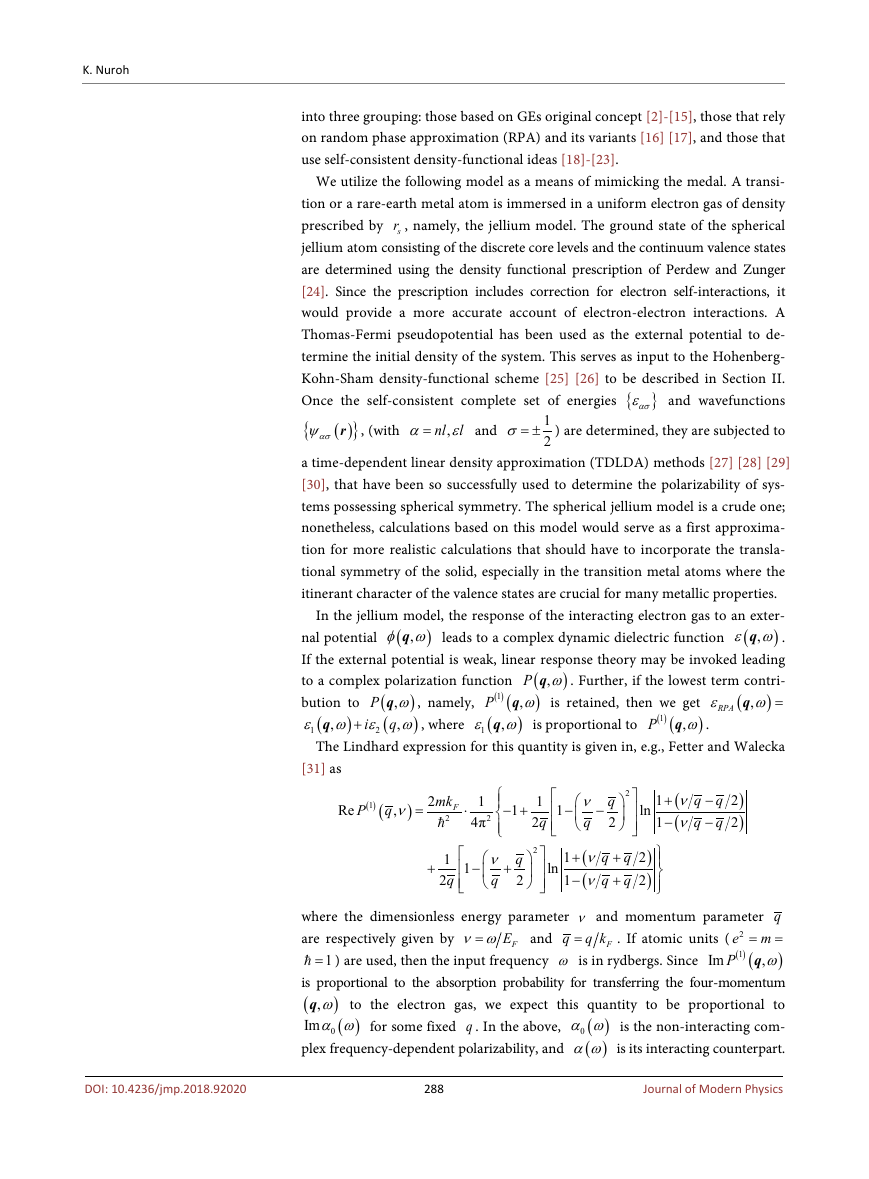
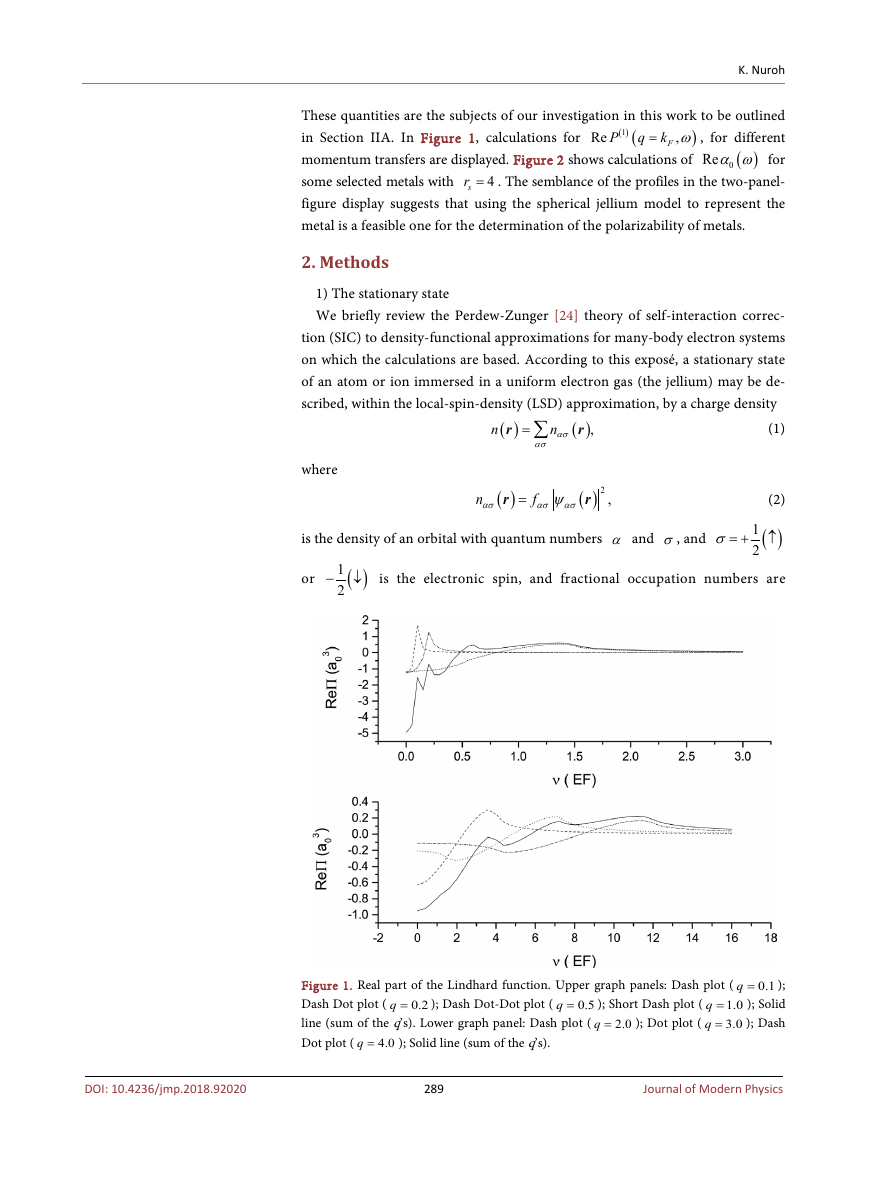
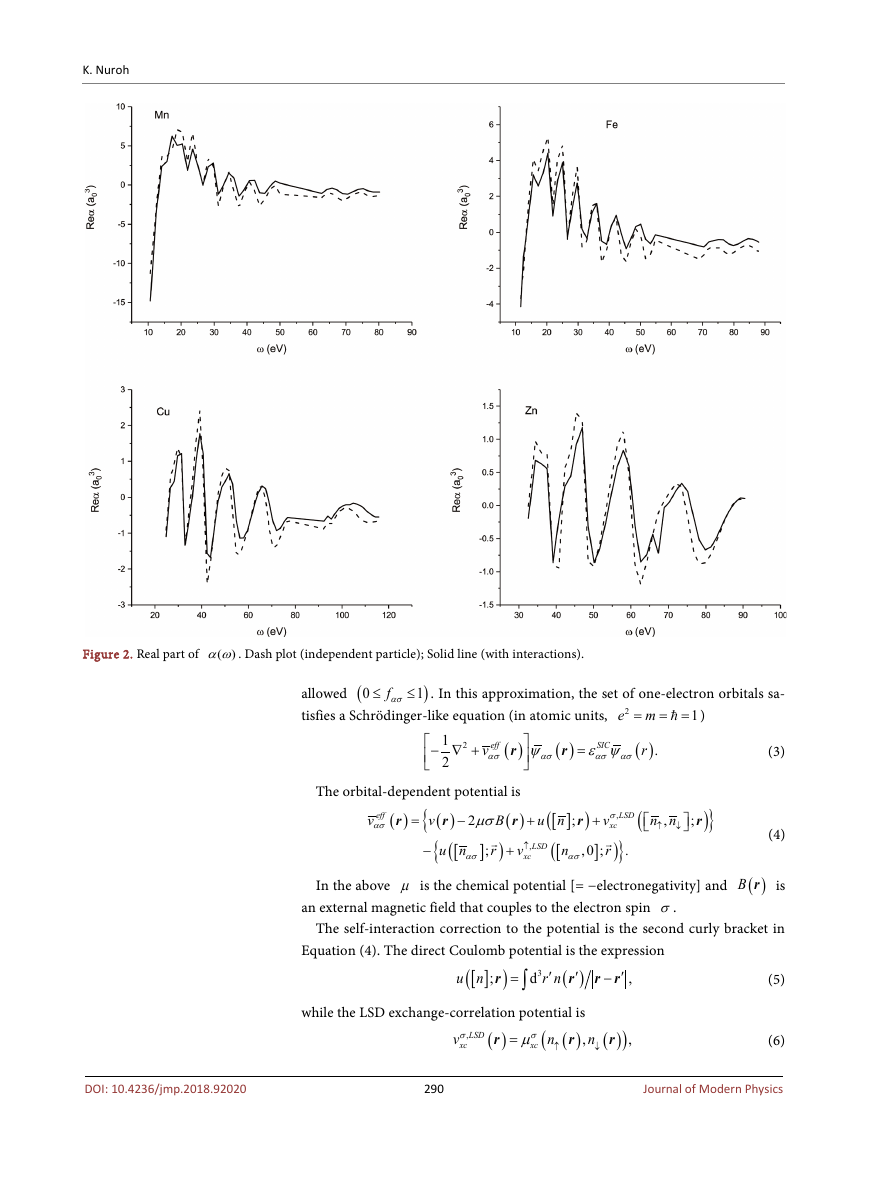
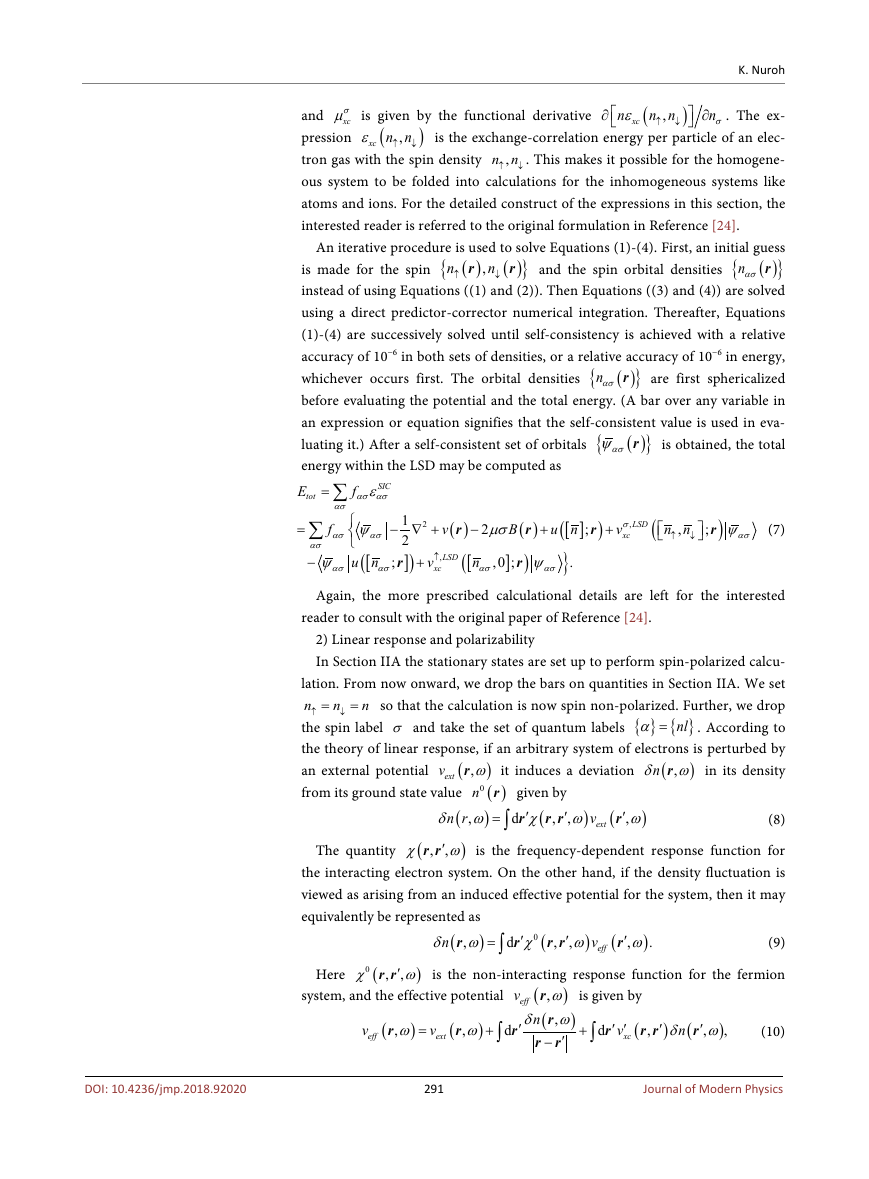

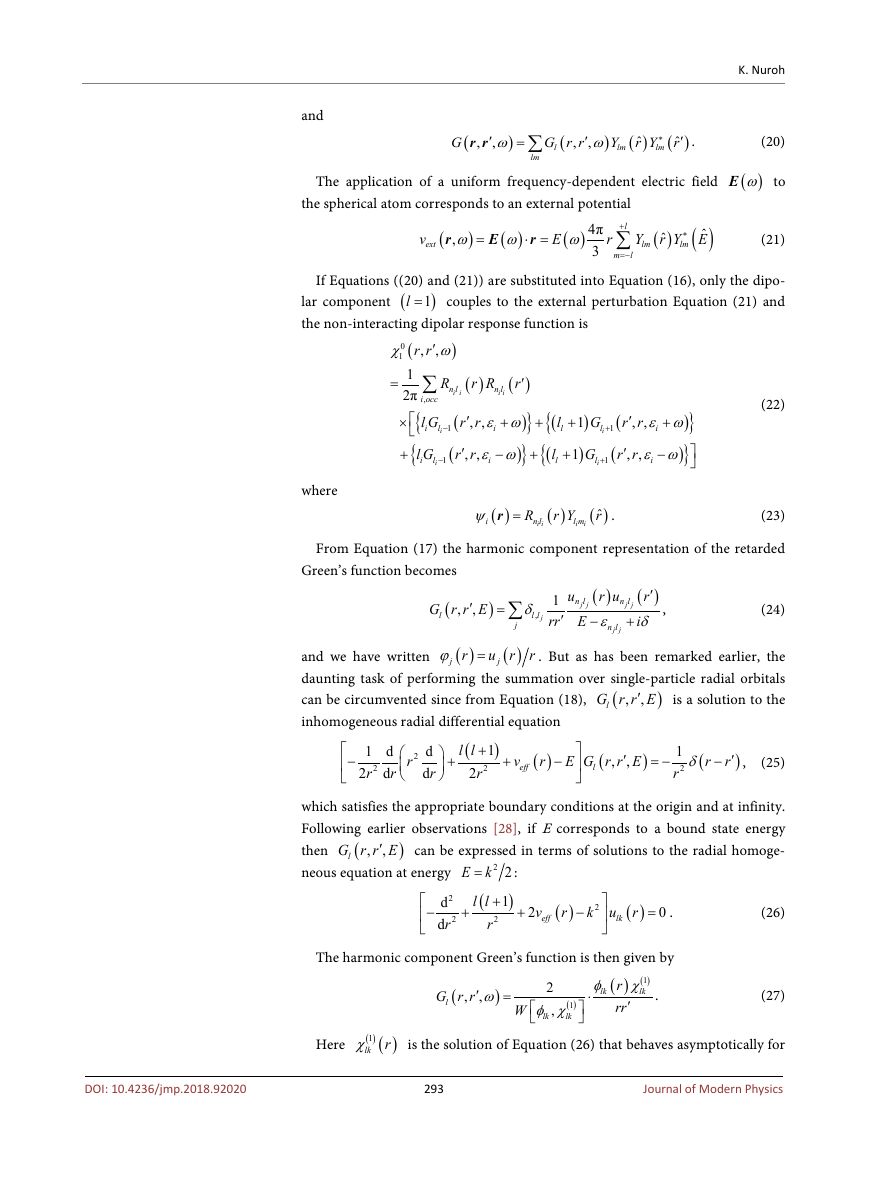
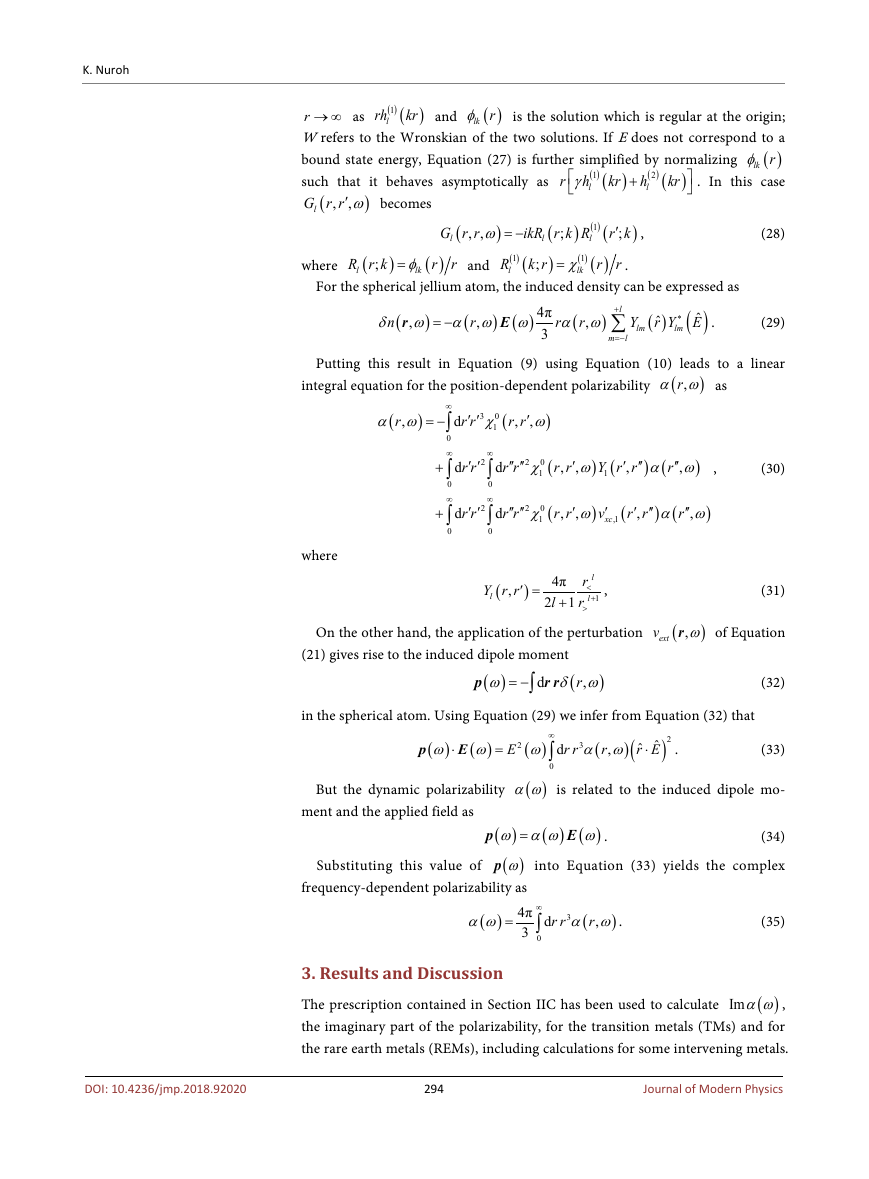








 2023年江西萍乡中考道德与法治真题及答案.doc
2023年江西萍乡中考道德与法治真题及答案.doc 2012年重庆南川中考生物真题及答案.doc
2012年重庆南川中考生物真题及答案.doc 2013年江西师范大学地理学综合及文艺理论基础考研真题.doc
2013年江西师范大学地理学综合及文艺理论基础考研真题.doc 2020年四川甘孜小升初语文真题及答案I卷.doc
2020年四川甘孜小升初语文真题及答案I卷.doc 2020年注册岩土工程师专业基础考试真题及答案.doc
2020年注册岩土工程师专业基础考试真题及答案.doc 2023-2024学年福建省厦门市九年级上学期数学月考试题及答案.doc
2023-2024学年福建省厦门市九年级上学期数学月考试题及答案.doc 2021-2022学年辽宁省沈阳市大东区九年级上学期语文期末试题及答案.doc
2021-2022学年辽宁省沈阳市大东区九年级上学期语文期末试题及答案.doc 2022-2023学年北京东城区初三第一学期物理期末试卷及答案.doc
2022-2023学年北京东城区初三第一学期物理期末试卷及答案.doc 2018上半年江西教师资格初中地理学科知识与教学能力真题及答案.doc
2018上半年江西教师资格初中地理学科知识与教学能力真题及答案.doc 2012年河北国家公务员申论考试真题及答案-省级.doc
2012年河北国家公务员申论考试真题及答案-省级.doc 2020-2021学年江苏省扬州市江都区邵樊片九年级上学期数学第一次质量检测试题及答案.doc
2020-2021学年江苏省扬州市江都区邵樊片九年级上学期数学第一次质量检测试题及答案.doc 2022下半年黑龙江教师资格证中学综合素质真题及答案.doc
2022下半年黑龙江教师资格证中学综合素质真题及答案.doc